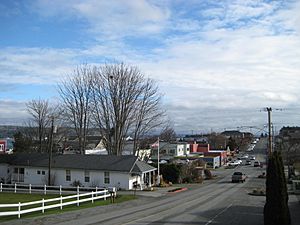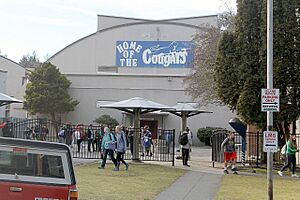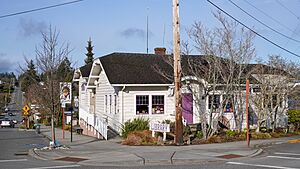Langley, Washington facts for kids
Quick facts for kids
Langley
sc̓q̓abac
|
||
|---|---|---|
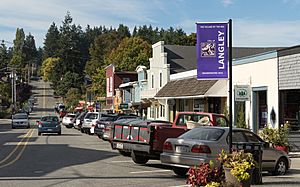
Main Street in Langley
|
||
|
||
| Nickname(s):
"The Village by the Sea"
|
||
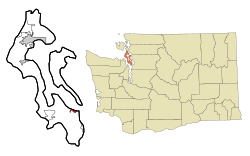
Location of Langley in
Washington |
||
| Country | United States | |
| State | Washington | |
| County | Island | |
| Incorporated | February 26, 1913 | |
| Government | ||
| • Type | Mayor-council government with 5 council members | |
| Area | ||
| • City | 1.58 sq mi (4.09 km2) | |
| • Land | 1.01 sq mi (2.61 km2) | |
| • Water | 0.57 sq mi (1.48 km2) | |
| • Metro | 26.2 sq mi (67.86 km2) | |
| Elevation | 0–90 ft (0–27.7 m) | |
| Population
(2020)
|
||
| • City | 1,147 | |
| • Density | 725.9/sq mi (280.4/km2) | |
| Time zone | UTC-8 (PST) | |
| • Summer (DST) | UTC-7 (PDT) | |
| ZIP code |
98260
|
|
| Area code(s) | 360 564 | |
| Telephone exchanges | 221, 321, 331, 341, 730 | |
| FIPS code | 53-38355 | |
| GNIS feature ID | 1512376 | |
| Annual budget | 2012, approximately $5.5 million | |
| Website | City of Langley | |
Langley (Lushootseed: sc̓q̓abac) is a small city in Island County, Washington, United States. It is located at the southern tip of Whidbey Island, offering views of the Saratoga Passage. In 2020, the city had a population of 1,147 people. Langley is sometimes called "The Village by the Sea."
Langley has been home to the Snohomish people for a very long time. They used the area for summer camping and had a village nearby. The modern town was started in the 1890s by Jacob Anthes and became an official city in 1913. Today, Langley is served by local fire and police departments and the South Whidbey School District.
Contents
Discovering Langley's Past
Early History and Native Peoples
The land where Langley now stands has been lived on by Indigenous peoples for thousands of years. The Snohomish people were the first inhabitants of south Whidbey Island. In their language, Lushootseed, Langley is called Lushootseed: sc̓q̓abac, which means "gooseberry bush."
The area was a popular spot for camping, especially for gathering clams in the summer. There was also a Snohomish village about a mile east of Langley at Sandy Point. This village had a large building used for special gatherings called potlatches, which brought visitors from far away.
American Settlement and Growth
Langley was founded in the 1890s by Jacob Anthes. He named the town after J.W. Langley from Seattle. In 1902, Anthes built a bunkhouse for loggers, which is still standing today and serves as the South Whidbey Historical Society Museum. Langley officially became a city on February 26, 1913.
In the late 1900s, some rabbits escaped from the Island County Fair. These rabbits created a large wild population that spread throughout Langley and south Whidbey Island. Their presence became a topic of local discussion, with different ideas on how to manage them.
The Olympic Club Building
The building known as "The Dog House" opened in 1908 as a fancy club for gentlemen called "The Olympic Club." Over the years, this building has been home to many different businesses.
During the time of Prohibition, when alcohol was illegal, the building secretly hosted boxing and wrestling matches. After Prohibition ended, it became a public bar and restaurant until it closed in 2008. The Clyde Theatre, a local movie theater, also started on the top floor of this building.
Langley Marina: A Place for Boats
In 2009, the City of Langley transferred the ownership of the Langley Marina to the Port of South Whidbey. This small harbor has 41 boat slips and a long dock area. It can hold boats up to 190 feet long.
The marina offers many useful things for boaters. These include restrooms and showers, water, and electricity at the docks. There is also a station to pump out boat waste and a ramp to launch boats into the water. However, there is no fuel available at the marina.
Marina Services and Facilities
- Boat docking spots
- Restrooms and showers
- Access to the beach
- Fishing opportunities
Education in Langley
Langley is part of the South Whidbey School District. The district has seen a decrease in student numbers over the past two decades.
Langley Middle School: Home of the Cougars
The first school built in Langley was the original Langley High School. It later became Langley Middle School. This school, known as the home of the Cougars, closed in 2017. Now, local non-profit groups and companies manage the building.
There are two time capsules buried near the middle school flagpole. One is set to be opened in the year 2055. The main school building has been turned into an art community classroom called the South Whidbey Community Center. The gym is now a CrossFit studio. The football field and track are still used by the Community Center. The science building now houses the Veteran's Resource Center of South Whidbey. The former school auditorium is home to the Whidbey Children's Theatre. The library building is now used by the Whidbey Dance Theatre and the Island Dance Studio.
South Whidbey High School: Home of the Falcons
The high school, known as the home of the Falcons, now includes grades 7 and 8 since the middle school closed in 2017. In 2023, grade 6 also moved to the high school building. So, grades 6 through 12 are all housed at the high school campus.
South Whidbey Elementary School: Home of the Dolphins and Orcas
The elementary schools, once known as the home of the Dolphins and the home of the Orcas, were built next to each other. They have now merged into one school, still using classrooms in both buildings. Grades K (kindergarten) through 6 are located at the elementary school campus.
Langley Library: A Century of Stories
The Langley Library is located in a historic building that was built in 1923. This public library is 100 years old and became part of the Sno-Isle Libraries system in 2010. The building, which is about 3,600 square feet, was temporarily closed on February 17, 2024, for renovations.
The renovation project is expected to cost $4 million. It aims to make the library more accessible and energy-efficient while keeping its historic look. About 1,400 square feet will be added to the lower level. During the 9 to 12 months of construction, the library is temporarily located in the South Whidbey Community Center.
Exciting Events in Langley
Mystery Weekend
Mystery Weekend is a yearly mystery game event. It happens during the last weekend of February. A fake newspaper story is published, giving clues about the mystery. Players then look for characters played by local residents to solve the puzzle.
Welcome the Whales Festival
The Welcome the Whales Festival and parade takes place at the beginning of April each year. This event celebrates the return of whales to the area.
Djangofest NW Music Festival
The Djangofest NW Music Festival is held every September. This five-day festival celebrates the Romani jazz style of Django Reinhardt. It includes workshops, concerts, and spontaneous jam sessions around town.
Whidbey Island Area Fair
The Whidbey Island Area Fair is held in July at the Island County Fairgrounds in Langley. The fair association was formed in 1912, even before Langley became a city.
Choochokam Festival
Choochokam was a popular annual event in Langley for 41 years. However, funding for it stopped. Local groups are now discussing ways to bring this festival back to the community.
Langley's Location and Size
Langley is located at 48°2′13″N 122°24′31″W / 48.03694°N 122.40861°W. According to the United States Census Bureau, the city covers a total area of about 1.08 square miles, all of which is land.
People of Langley: Demographics
| Historical population | |||
|---|---|---|---|
| Census | Pop. | %± | |
| 1920 | 274 | — | |
| 1930 | 268 | −2.2% | |
| 1940 | 338 | 26.1% | |
| 1950 | 427 | 26.3% | |
| 1960 | 448 | 4.9% | |
| 1970 | 547 | 22.1% | |
| 1980 | 650 | 18.8% | |
| 1990 | 845 | 30.0% | |
| 2000 | 959 | 13.5% | |
| 2010 | 1,035 | 7.9% | |
| 2020 | 1,147 | 10.8% | |
| U.S. Decennial Census | |||
Population in 2010
Based on the 2010 census, Langley had 1,035 people living in 555 households. About half of these households (271) were families. The city's population density was about 958 people per square mile.
Most of the people in Langley (94.1%) were White. Other groups included African American (0.1%), Native American (0.6%), Asian (1.6%), and Pacific Islander (0.1%). About 2.8% of residents were from two or more races. Hispanic or Latino people made up 3.2% of the population.
In terms of households, 16.6% had children under 18 living with them. About 39.1% were married couples. The average household had 1.86 people, and the average family had 2.51 people. The median age in the city was 57 years old. About 14% of residents were under 18, and 28.4% were 65 or older. The population was 40.9% male and 59.1% female.
See also
 In Spanish: Langley (Washington) para niños
In Spanish: Langley (Washington) para niños



